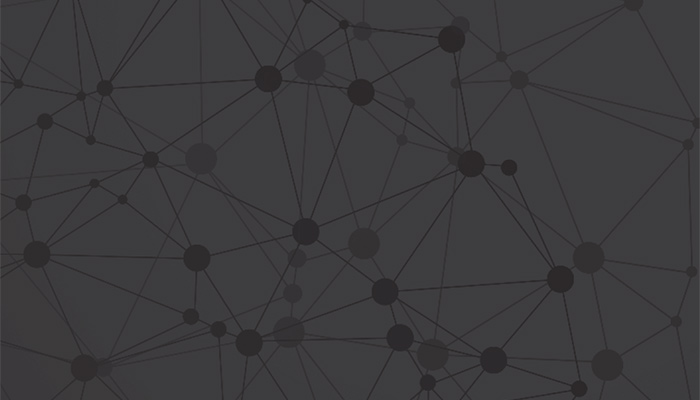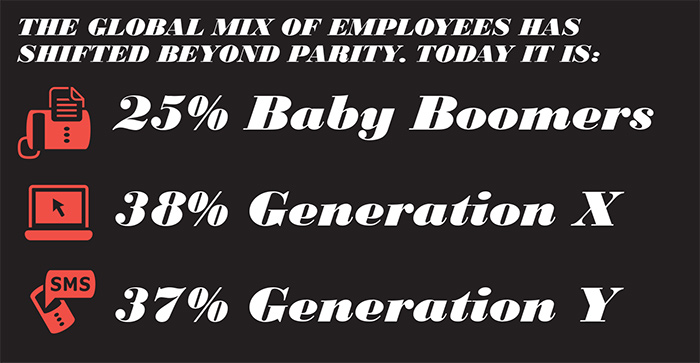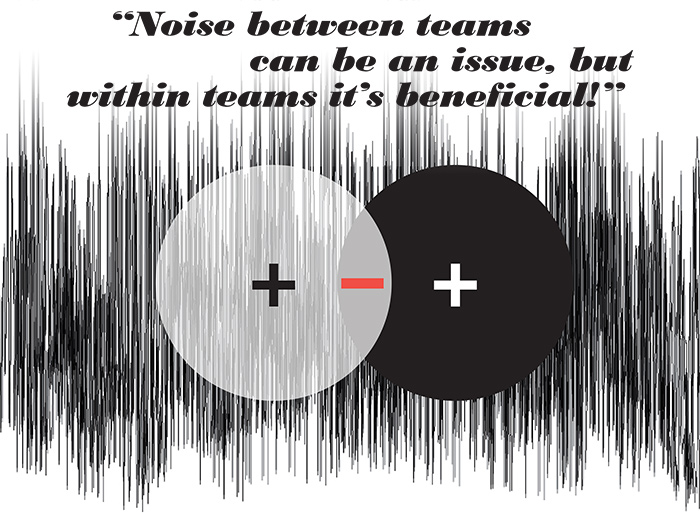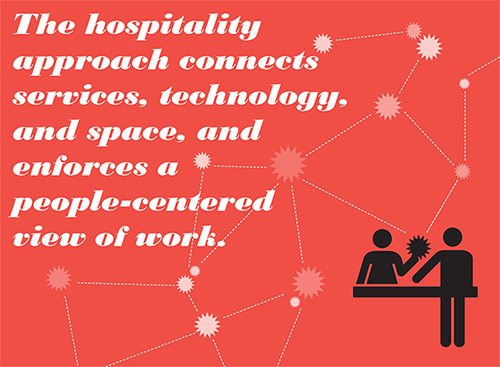The embedded asset has been deleted:
Asset Type: Knoll_Document_C
Asset Id: 1353009010024
PAGENAME: Knoll/Knoll_Document_C/EmbedDocumentLink
The office today is at the nexus of the social, the technological, and the physical worlds in an evermore global experience. We have a rich opportunity to create a more connected workplace, a net.work office that puts people at the center of their life-work experience.
Introduction
and
Methodology
Contemporary workplace practices are more mature and have a broader reach within organizations today. Knoll, in partnership with Unwired Ventures, sought to better understand what is coloring the modern global workplace. What are the various real estate and facility options in practice? How are they being interpreted locally? How is this spread of practices—distributed work, flexible work, and evolving technology—effecting employee engagement?
The research findings speak to the impact of multinationals and the current state of managing global real estate portfolios. We discovered that workplace practices are being analyzed more deeply, driving new workplace planning paradigms and yielding a richer workforce experience. As workplace solutions go global, best practices are being localized. Local interpretations of global practices are often influenced by relevant criteria:
-
Flexible work policy deployment
-
Leveraging of existing real estate assets
-
People-centric focus
-
Global workplace experience
The exploration led to a new notion that collides at the intersection of a social network with physical real estate, a live net.work experience. This intersection is being driven by hospitality demands on the traditional facility model. Reflect on the global workplace models that follow as they are interpreted and retold from around the world, and consider the emerging patterns that warrant even new questions.
The survey included both qualitative and quantitative input options with the advisory board providing opportunities for deeper investigative interviews.
The
Workplace
Today
Three distinct tiers of office models exist today: the physical present where everyone shows up and work is conducted primarily on site; the virtual state—an asynchronous model where people choose to work anywhere and at convenient times; and a hybrid that balances physical presence with the virtual mobile world.
For many of today’s knowledge workers, the office is still largely based around ideas of physical work that originated in the production lines of the Industrial Revolution, where a strict division of labor meant efficiency and profit. In offices, this approach translated to process-driven, task-based work conducted under intense supervision, a model facilitated by employees present at designated desks in arrangements that modeled efficiency and mirrored a set hierarchy.
As automation reduced the need for taskbased work, the value placed on creative, knowledge-based work increased. But knowledge-based work is less predictable; it cannot solely be reduced to processes and tasks. Connections that foster success are often unplanned and spontaneous. Modern creative workers require new ways of collaborating in new kinds of space to deliver the agility and flexibility demanded by today’s businesses.
This flexible vision for the physical office is made possible by new thinking about where work can happen, and is enabled by the full-time connectivity of the cloud and increasingly fast and ubiquitous data networks and devices. External forces also drive it. Companies are being forced to rethink how they acquire, plan, and use physical space in the face of changing cities, increased financial pressures, and the demands of global markets.
Real estate costs often represent the second largest overhead expense and are a significant fixed and relatively inflexible cost for companies. The average annual cost of providing a desk in London or New York is $18,000. A typical professional services firm spends an estimated 23% of revenue to cover overhead, and real estate costs may equal 6% of profit. Moreover, real estate is forced to be more reactive to economic cycles and the market. Often, companies find themselves with too much space, with the wrong type of space in the wrong location, or with a portfolio misaligned with their business goals.
Utilization of these assets is very low: On a typical day, desks are in use only 47% of the time while meeting room utilization tracks between 50-60%1 yet people feel they cannot find a place to meet.
As companies acknowledge these realities, they have responded with how they allocate space by breaking the tenet that one person needs one desk. Efficiency metrics are changing as well, moving from cost per square foot to cost per person, and from square feet per person to square feet per work group. This translates into smaller footprints—often shrunk by 30%—which not only reduce capital and operating costs, but also provide a better mix of space and a more energized environment.
What does this new workspace look like? Interviews with real estate and facilities leaders around the world confirmed a changing mix to the office. Businesses are changing that mix by creating more meeting spaces and reducing the number of traditional desks. Companies are also making an increased commitment to “soft” collaboration areas like “all hands” spaces for gatherings and town halls and new hospitality approaches such as inviting work cafés.
Research shows these investments are both successful and popular. Firms report that providing great workspaces is recognized by the workforce and generates a cultural shift causing people to want to be in the office. And our survey results concur: 54% of respondents report a tighter alignment between workplace culture and corporate vision.
There have been some notable cases, especially in Silicon Valley, of companies requiring staff to spend more time in the office. Our research suggests, however, that this drive towards “presenteeism”—focused largely in the US—is a response to the specific circumstances of those companies rather than a wider trend. It counters our global findings showing 66% of companies surveyed have no formal policy to actively bring people back to the office. While a shift back to the office has a following, the global trend of allowing employees to choose where to work shows no signs of reversing. Adoption of this practice is escalating abroad with over one third of the global respondents indicating that workplace choice is more and more being left to the employee. And the generational mix of employees has shifted beyond parity. Today, 25% are Baby Boomers, 38% Generation X, and 37% Generation Y.
Even as organizations allow, and often encourage staff to work flexibly, we know that spontaneous interaction is linked to innovation. In his book Where Good Ideas Come From, Steven Johnson demonstrates that innovation needs proximity. “The most inventive places,” he tells us, “are hives of activity.” This presents an ongoing dilemma: how can a company stimulate innovation when the right people are rarely in the same space at the same time?
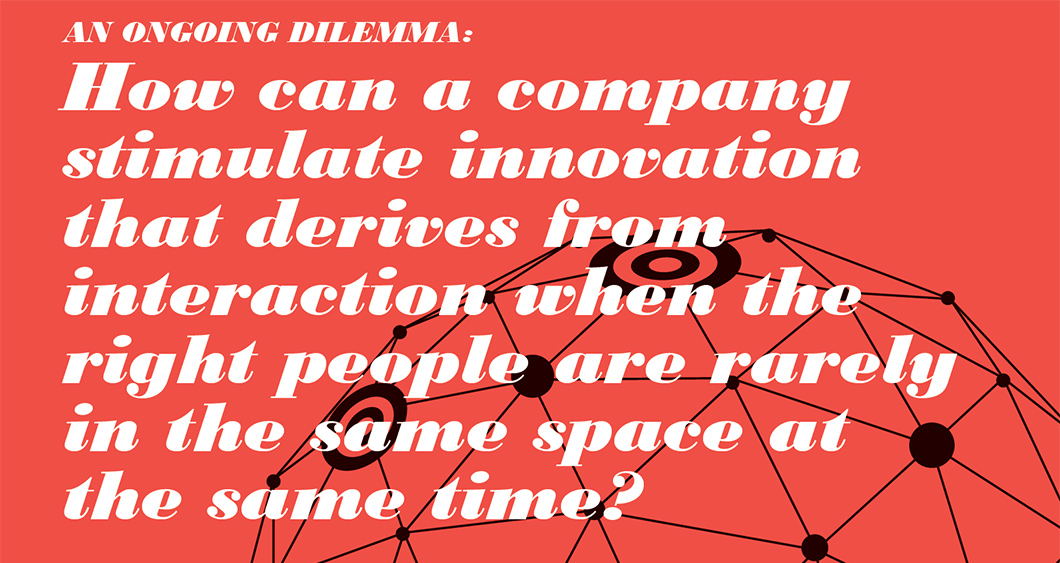
Workplace
Interpretations
Flexible work, choice of place to work, and more targeted people to seat ratios—all present new opportunities for reconsidering facilities utilization rates and the ultimate real estate portfolio.
The advent of the paperless office coupled with increasing automation of many administrative tasks created a large surplus of space in some offices. Adding that only 23% of executives surveyed actively encourage staff to work in the office, the office landscape is shifting.
This shift has been enormous in some sectors—such as professional services and consulting—where working away from the office is the norm, Accenture has achieved a 40% reduction in their UK portfolio and reduced real estate in the US by 70%, from 3 million to 900,000 square feet. For Accenture, this has been a carefully managed, thoughtful transition, facilitated by technology, and driven by people-centered thinking. “For both consultants and corporate functions there’s a choice of places to work: Accenture, client sites, home, or third spaces,” says Daniel Johnson, Global Director Workplace Innovation at Accenture. “The goal is to support work, and ensure we deliver the best work regardless of the specific location.”
Where working out of the office is less ingrained in the company culture, groups have achieved smaller but still substantial space savings through flexible planning. The BBC, reports Chris Kane, Head of Corporate Real Estate at BBC, has “reduced space by 30% through good husbandry and some flexible working. We have many people who don’t have a dedicated desk.”
This trend towards a smaller footprint, more aligned to the average day-to-day demand for space rather than the scenario of every employee in the office at the same time, allows companies to reduce real estate overhead and rethink office planning.
The global trend of allowing employees to choose where to work shows no signs of reversing.
Actual implementation varies. Some companies take a building-by-building approach, merging or consolidating facilities into a smaller number of sites. Others have restructured their real estate portfolio to concentrate activities, often in lower-cost space outside city centers.
Some organizations are taking a more comprehensive, workplace-oriented approach. Instead of focusing on specific buildings, they are planning their office space as part of a broader strategy around flexible working. Metrics-driven companies have adopted specific ratios for the number of employees per desk; others take a team-based approach and allocate a given amount of floor space to each team, allowing managers some flexibility in creating a place where employees feel a sense of belonging.
eBay exemplifies this growing trend, giving individual teams a degree of flexibility over the layout of spaces and the choice of furniture and fittings. Team spaces that can be selfconfigured and changed by their inhabitants are also finding favor in broader industries like professional services.
We encountered clear regional differences in how organizations manage this new workplace landscape. National Australia Bank is shifting employees from central offices to local offices. This is driven by a need to put staff nearer to business customers and build local brand presence within an existing real estate portfolio. Monica Klyscz, Head of Property Solutions, Shared Services, Enterprise Services and Transformation at National Australia Bank, explains: “Our strategy is underpinned by flexible working, enabling a greater level of collaboration and shared working environments, and greater connectivity.”
In parts of Asia, however, flexible working and the move away from personal desks have met with cultural resistance. Even in fields like professional services, where staff works at client sites for much of the day, there is a perceived sense that employees should start and finish the working day at their own office.
Thin
Buildings
Just as the paperless office freed up valuable space, the move to cloud computing is changing the size and shape of the modern office. Using cloud storage allows companies to remove equipment rooms and release rooms or even whole floors for other uses. The resulting “thin” buildings may only contain some network switches. Servers go and with them their infrastructure—power and cooling, voids, risers, floor loadings, and fire suppression systems—is no longer needed. Buildings can be simple again—places for people and not containers for equipment.
These thin buildings, stripped of outmoded infrastructure and technology, take up less space and need fewer technical staff to run them. As companies roll out “choose your own device” policies, the desktop computer becomes optional. Organizations have devised interesting ideas for this newfound space, using it for “chill out” spaces, gyms, music rehearsal rooms, and cinemas. Around the world, buildings are becoming more people-centered.
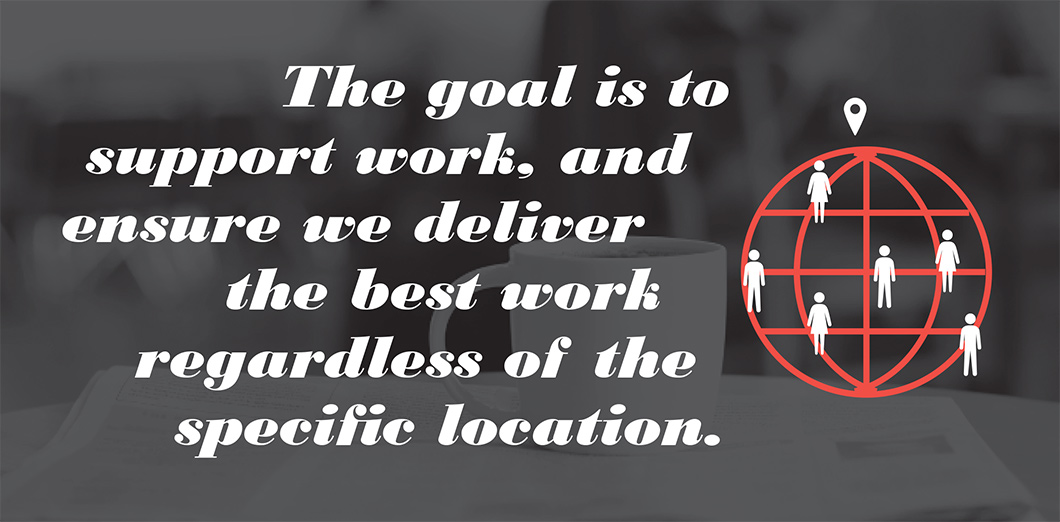
Back to
the Office
“Home”
A more holistic approach to work and workplace is a key feature of the start-up community, especially in centers such as Stockholm, Berlin, London, and San Francisco. Founders may see the ability to work more flexibly as a major reason for launching their own company. It may be a lifestyle choice, but it can also support a more agile and responsive business platform. Incorporated into a wider approach to workforce management, flexibility is also a tool for recruitment and retention. Research by Deloitte suggests that flexible working can improve the retention of high performers by as much as 100%, as well as improving employee engagement.2
Organizations need more high quality, adaptable spaces that cater to a wider variety of worker.
While our global survey shows no signs this trend will change, people need a home, even if they are often away from it. Striking the right balance will drive significant workplace change in the next few years. As organizations seek to define this “home,” they are making the office more inviting, not just for meetings and events, but also to foster informal collaboration and knowledge sharing. Companies like Nokia are actively promoting such a balanced approach, blending flexibility with an attractive office culture.
Juha Olkinuora, Vice President of Workplace Resources at Nokia explains: “In the old Nokia the rule was that you had to spend four out of five days on site, [while] at Nokia Siemens Networks [a predecessor firm to the current Nokia] people were more encouraged to work also from home.” Today, the firm is trying to reach a new balance between workplace options and efficiency, in which the office and alternate workspaces both play essential roles.
It is clear that the office will play a slimmer but still vital role in the work of the future, and the results of our survey help articulate that role. In addition to getting work done, global respondents emphasize that the office is a space for connecting people and supporting culture. The office as a place to access technology ranked low, a shifted finding from prior reports, which supports our observations on the increasingly untethered nature of workplace technology.
WORKSPACE, NOT DESK SPACE
What are the new goals for office space? Organizations need more high-quality, adaptable space that caters to a wider variety of workers: local employees, staff from other offices, clients, freelancers, and guests. Many companies referred to the challenges of hosting external teams effectively, describing a workplace that needs to become at times more like a hotel, a hospitality workplace.
Multinationals have taken workplace programs global. “We are moving from individual workstations to team based spaces,” says Brian Collins, Director of Global Workplace Strategies at Microsoft. Microsoft is one of the foremost proponents, and adopters, of flexible working, activitybased working, and a new way of thinking about office space across all of its European locations, with London, Helsinki, Zurich, Amsterdam, and Madrid leading the way. “We know that people are choosing to work in a very personal way, choosing when, how, and where they work.”
Monica Klyscz at National Australia Bank describes a similar scenario: “More than three quarters of our sites in Australia use activity-based working principles. We need to be efficient in accommodating changing teams and business environment.”
Moving furniture and partitions rather than rebuilding walls and shifting services allows for the variety modern workers demand.
Facilities managers queried for this investigation explained that one of their greatest challenges in meeting these new demands is to continue providing enough space for desk-based work without damaging flexibility by requiring staff to book space ahead of time. After all, desks are now just one in a wide array of spaces the modern knowledge worker needs to be productive. Facilities managers report a growing demand for “quiet” working spaces, and booths suitable for concentration, conference calls, or individual video conferencing in addition to multi-purpose cafés and outdoor spaces.
This new, diverse mix of space is especially evident in the tech industry. Tom Gill, Vice President and CIO at Plantronics explains what it means for his company: “For engineering teams—and teams in general—collaboration is the key. Our goal is to have space where virtual or face-to-face collaboration can take place. It is also important to have focus areas, supporting not just teamwork but independent work. We try to provide the most appropriate space to work given the task to be performed.”
As tech companies increasingly recognize the importance of all types of interaction, they are designing spaces that allow people to move between teams, as well as integrating development teams more tightly into the main office space. “In R&D we have collaboration all day in SCRUM areas,” says Johanna Ihalainen, Senior Manager, Business Relationship and Workplace, Nokia. “They have individual desks and meeting facilities and screens and whiteboards. Sometimes we have to separate the teams. Noise between teams can be an issue, but within teams it’s beneficial!”
Organizations are also starting to distinguish between collaboration and meeting areas within team spaces, and those that are designed for general company use. This zoning and re-zoning, balancing the private with the public, is sometimes being left to the discretion of team or department managers. In some companies, this means allocating a departmental budget for furniture and fittings expenditures.
In all of these spaces, the emphasis is moving from an outfitted space towards furniture that provides a landscape and articulates the office floor. Businesses may also set some ground rules, to segregate noisy and quieter work tasks, for example, or to balance public and private space. Creating more interesting footfall can engineer chance encounters, designing hubs for people to meet and work together.
In the UK, for example, the BBC uses internal staircases to encourage intra- and interdepartmental collaboration. “It’s no more complicated than that,” says Chris Kane. “And technology makes it even better as the need to be tethered has gone away for most people.”
The exact allocation of space, though, depends on national culture as well as on the roles performed by different teams. In some parts of Asia there is still a preference for formal meeting spaces and personal desks. Asian companies are responding to the trends described above. Companies in the region are including more informal collaboration spaces, more in-house catering, and more welfare-focused areas, such as spaces for thinking and relaxation.
64% OF RESPONDENTS SAY THEY FACE A GROW ING DEMAND FOR COLLABORATION AND FORMAL MEETING SPACE.
When they have access to this mix of space, workers use it. Our research shows that employees spend only 55% of their time at their desks, against 21% in meeting spaces and 11% in common areas like cafés.
BUILDING QUALITY WORKSPACE
Today’s office is competing with other venues, and companies must invest in the office so that workers see it as useful and visit more often, improving engagement and building community.
Facilities managers agree that providing thoughtfully designed “hospitality” such as quality coffee and great technology is not a luxury if the office is to function as a modern business hub.
“Start with the pipes,” advises Plantronics’ CIO, Tom Gill. “Wi-Fi has to be very robust to serve a dense population. We have flat screens in all our scheduled and informal meeting areas, and our drop-in stations have monitors and keyboards.”
But it is often the softer services that make the biggest difference. “We have a highly standardized operating model so there is a predictable experience whichever office you are working from,” says Accenture’s Daniel Johnson. “We offer a range of support, delivered by self-service applications, shared and dedicated resources based on need.”
The move to concierge service is changing the nature of these shared environments. At some offices, a host, often created from a combined facilities management and IT support function, provides a one-stop shop for all support needs, from travel to technology and personal shopping, dry cleaning, to bicycle repair.
While the cost for these extra services may seem extreme, it offers employees a recognizable exchange for the loss of their dedicated desks. The hospitality approach connects services, technology, and space, enforcing a people-centered view of work that supports the cited top roles per this study of the office: creating lifestyle, building camaraderie, and enhancing employee’s work-life balance.
An Office
Typology
If the first generation of the office was about paper and manual processes, Office 2.0 was about technology, especially the personal computer, email, and emerging mobile devices.
Office 3.0 takes account of the possibilities and benefits of the current generation of technology and the flexibility being demanded by corporations, and exploits them to create a people-centered, productive space.
IN A 3.0 OFFICE, STAFF IS THERE ABOUT HALF THE TIME. ACCORDING TO OUR PERCENTAGE RANKING QUESTION, WORKFORCES SPEND 49% OF THEIR TIME AT CORPORATE HEADQUARTERS, AGAINST 27% AT SATELLITE OFFICES, AND 17% AT CLIENT SITES. EMPLOYEES SPEND 16% OF THEIR TIME WORKING FROM HOME AND 6% IN “THIRD SPACES.”
This new space is built around the shift from asynchronous work to synchronous collaboration, in which several people work on the same content at the same time. To support this serendipity, 61% of the survey respondents are investing in richer video and content-sharing technology.
CONTEMPORARY OFFICE DESIGN
Office 3.0 looks different. The furniture articulates a space that provides fewer dedicated desks and more alternative workplaces. In this approach, perimeters with natural light and views are devoted to shared environments. Private offices, if they exist, are shared as meeting rooms when their occupants are away.
Design can create casual collisions and help to engineer the serendipity between knowledge workers.
At Microsoft’s Netherlands headquarters just outside of Amsterdam, no one has a fixed desk or office, and technology has been designed to keep people connected to people. Staff use portable devices including laptop computers and smartphones and have adopted softphones for communications that use Microsoft’s Lync software (now Skype for Business). As Brian Collins explains, “we want to showcase our brand and our products in the workplace.”
Shared desks mean higher occupancy and greater efficiency, but also a sense of energy giving the workplace a pulse. “Efficient desk sharing does make it possible to get more people in. For years we’ve provided 20 people with 12 desks. In previous studies our utilization was 40-45%, now it is as high as 80%,” says Derrick Bock, Head of Workplace Design at eBay.
At eBay, shared desks are balanced by a variety of collaborative spaces, the kind of productive, interactive meeting places that can accelerate processes and reduce time to market. “For every two desks there’s a conference room seat. But we also create scenes for casual collisions between staff,” says Bock.
These intersections are essential to Office 3.0. Design can create casual collisions and help to engineer the serendipity between knowledge workers for which companies strive. By putting people from different disciplines together, Office 3.0 breaks down silos of departmental location. And by disrupting traditional arrangements and creating “inefficient” footfall, it can force people to move around the corporate floorplate, to meet and interact.
CREATING A HUB
Are we seeing a return to paternalism, where work and the workplace are intertwined with employees’ lives and wellbeing?
Creating a connected office requires more than physical design. It means rethinking how offices are managed and integrating facilities management tasks with human resources, business units, IT, and senior management.
Indeed, the investment case for new or upgraded office facilities may be easier to make if it is tied to business goals such as potential performance gains, better customer service, and easier recruitment and retention. Progressive companies are looking at integrating real estate choices and office design with a wider workforce strategy, rather than asking the workforce to adapt to the available real estate and facilities.
Creating this kind of workspace may well mean spending more per square foot than a standard design, but the cost can be offset by greater efficiency and workforce satisfaction, a better presence in front of customers, and a lower cost of churn.
66% OF ORGANIZATIONS SAY THEY TIE THEIR WORKSPACE DESIGN AND UTILIZATION INTO A WIDER WORKFORCE PROGRAM.
Two years ago, Ernst & Young (EY) inaugurated a holistic, flexible workplace program across the UK. “It is a fully managed program, based on a trust culture,” explains Andrew O’Donnell, Head of Real Estate, UK and Ireland at Ernst & Young. “You should be working where you feel you should be working to deliver for our internal and external clients. As a product of this change the office is becoming a hub. We still have people who want to have their heads down, but most people are not doing ‘sole laptop’ work but collaborating in and outside of the office.” EY is growing this program globally.
IT’S ALL ABOUT THE PEOPLE
EY’s vision for its workplace is peoplecentered at its core. As part of its office refurbishment, EY is adding wellbeing facilities including spaces for classes and for dentistry and massage. “We are considering how we expand our lifestyle services in house,” says O’Donnell. “It’s becoming more important for a number of reasons. It is better for attracting and retaining talent, and in our sector, competition is fierce.”
Are we seeing a return to paternalism, where work and the workplace are intertwined with employees’ lives and wellbeing? If so, today’s version of paternalism is more pragmatic. It is about the shift in work that will force organizations to compete for talent. It is about the workplace’s central role in both attracting and retaining the best people. It is about creating an experience that meets the needs of today’s knowledge workers.
net.work
Place
We see a new kind of space. It’s a space enabled by the Internet of Things, in which the office—and those who use it—will know who is in and where they are. Combined with social networks, connected real estate will provide physical social networks that promote the chance encounters that companies need to be nimble, encourage innovation, and achieve competitive advantage.
As real estate moves from business overhead to business driver, it is producing clear benefits. Facilities accommodate the organization and the work that needs to be done, serving as a tool in the recruitment and retention equation, and creating communities and clusters that drive the interactions that make knowledge workers engaged. The real estate is the epicenter of the desired “buzz” within the hive.
The net.work building will be smaller and thinner, richer in design, with a set of interior spaces that matches people and their activity to the space, technology, and content they need to do their work.
We have seen the creative potential and importance of the physical office as a hub, but today its role is sometimes left to chance or realized by employees who take initiative. This ad hoc model has the potential to change as technology increasingly connects inanimate objects into an Internet of Things. Real estate will become networked; it will be able to report on real-time utilization, tracking everything from “what’s on” to “who’s in”, it becomes one of the “Things.”
This “who’s in” tracking will mark one of the most fundamental changes in the role of real estate. Smart energy management systems already allow buildings to adjust energy use based on occupancy, and headcount sensors help managers provision food and other services.
Today we rely on separate social networks to track our relationships and connections as well as our activities, ideas, and encounters. Can a new kind of network be established to connect us to our spaces, people, and work?
Rather than replicating the corporate hierarchy, the office will reflect the organization’s network of employees, customers, and partners. Social networks will merge with buildings to create real-time real estate—a live social network where people are brought together because they are in the same space at the same time and have something in common. This location-aware world where serendipity can be engineered will be the inevitable consequence of this era of knowledge-based work.
As buildings and social networks come together, people will use near field location aware systems for a range of experiences, from wayfinding to arranging lunch. Realtime presence will also create a building that knows, and can begin to provide a dashboard view of how well it is aligning space to activity and demand. Big data will inform design and facility management, providing information on everything from wait time for elevators or the coffee line to people’s circulation patterns, allowing for new decision making and creative solutions.
The office will become the main place for the realization of a new net.work. This intersection of the Internet and the digital with the building and the physical will unite the two realms that have only now simply flirted with each other.
Where
Next
The ongoing debate about the future of the office has focused on whether the office has a future. Researchers and pundits suggested that the office—at least in the form we have known it—would go away. Instead, they predicted, knowledge workers would be nomadic, moving from place to place connected only by wireless data and smart devices.
This prediction has not proved entirely accurate. Though companies have reduced layers of administration through automation and cut their space requirements, they have expanded activities in other space-intensive areas like sales, customer services, technology, marketing, product development, and R&D.
OUR SURVEY CITED WORK-LIFE BALANCE AS THE MOST IMPORTANT REASON FOR ALTERNATIVE WORK STRATEGIES, AHEAD OF COST SAVINGS, SPACE OPTIMIZATION AND BUSINESS AGILITY.
The psychology of location is changing. People commuted to Office 2.0 because the paraphernalia for work was there: the files, the phone, and the PC. Now they commute to the Office 3.0 for different reasons based on opportunity, culture, and outputs rather than habits, reporting, or contracts that stipulate a “place of work.”
A workplace vision that facilitates a life balance is an important recruitment tool, and the office will undergo further change to support it. This evolution to a net.work experience may well be in smaller space, but it will be more hospitable and responsive than ever before. A key part of that will be adaptable physical design and floor plans that allow spaces to be configured and reconfigured to meet the changing needs of the workforce.
The psychology of location is changing. People commuted to Office 2.0 because the paraphernalia for work was there: the files, the phone, and the PC. Now they commute to the Office 3.0 for different reasons based on opportunity, culture, and outputs rather than habits, reporting, or contracts that stipulate a “place of work.”
A workplace vision that facilitates a life balance is an important recruitment tool, and the office will undergo further change to support it. This evolution to a net.work experience may well be in smaller space, but it will be more hospitable and responsive than ever before. A key part of that will be adaptable physical design and floor plans that allow spaces to be configured and reconfigured to meet the changing needs of the workforce.
This net.work office is more open, and more social. It allows for orchestrated collaboration via a live network and promotes the free flow of ideas as real estate, technology, and people become more closely connected. It will also continue to present an organization’s values to customers and the public. This new office escalates the role as a hub for the business, rather than a place for task-based work.
Real-time real estate will witness the collision of social networks and physical space to enhance these experiences, connecting people based on their location, knowledge, and preferences. The space experience will be that of an enabled connector, transforming Office 3.0 from an inert container to a live net.work.
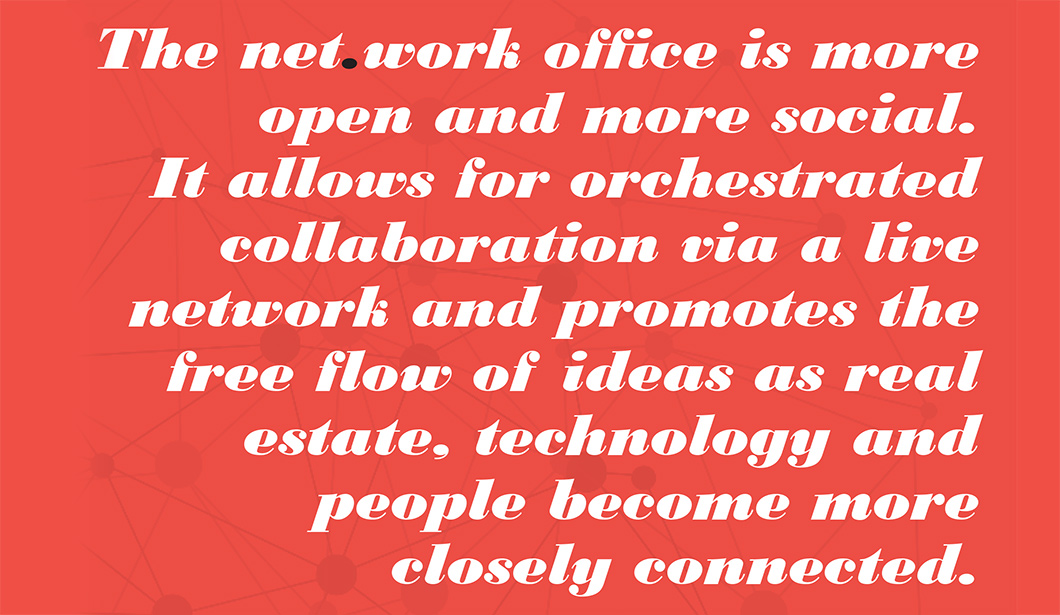
Glossary
“All hands” space: A meeting space large enough to allow all members of the company (or location) to attend. This is often a multipurpose space, such as a cafeteria or atrium.
Activity-based working (ABW): A workplace strategy that provides people with a choice of settings for a variety of workplace activities. In an activity based work environment, workers are not assigned a specific workspace. Instead, they choose where to work depending on their current task.
Baby Boomer: A person born during the post-World War II baby boom years from 1946 to 1964.
Choose your own device: Employees use their personal smartphones, laptops, and other tools at work.
Churn: The rate at which employees leave a company.
Cloud computing: Storing and accessing data and applications on the Internet rather than on a local server or a personal computer.
Connected real estate: Buildings and spaces enabled by the Internet of Things, where the office and those within it know who is in the office and where they are located.
Footfall: The number of people entering a particular area at a given time.
Footprint: The amount of floor space required for a particular workstation, function or work group.
Generation X: People born from 1965 to 1978.
Generation Y: People born from 1979 to 1997 (some demographers cut this group off at 2000).
Internet of Things (IoT): A system of inanimate objects networked via the Internet. Overhead: All costs except direct labor, direct materials, and direct expenses. Overhead includes labor costs and real estate expense.
Paternalism: A management practice that interweaves work and workplace with employees’ lives and wellbeing. Industrial revolution pioneers like Cadbury, Pulman and Ford originally envisioned paternalism.
Presenteeism: The practice of coming to work despite sickness or injury.
SCRUM: A methodology for managing product development often used in developing software. SCRUM teams work as a unit and usually meet daily.
Third space: A place to work that is neither office nor home. Third spaces may be found in client sites, airport lounges, hotels, cafés, and more. Ray Oldenburg first used this phrase in his book The Great Good Place.
Wayfinding: Signs, maps, and other graphic methods used to convey location and directions to travelers or visitors.
Thanks and Acknowledgements
We would like to thank the following individuals who gave invaluable input and insight for this report as well as others who preferred to remain anonymous:
Derrick Bock, Head of Workplace Design, eBay
Brian Collins, Director Global Workplace Strategies, Microsoft
Tom Gill, Vice President and Chief Information Officer, Plantronics
Johanna Ihalainen, Senior Manager, Business Relationship & Workplace, Nokia
Daniel B Johnson, Global Director, Workplace Innovation, Accenture
Chris Kane, Head of Corporate Real Estate, BBC
Monica Klyscz, Head of Property Solutions, Shared Services, Enterprise Services and Transformation, National Australia Bank
Andrew O’Donnell, Head of Real Estate, UK & Ireland, Ernst & Young
Juha Olkinuora, Vice President of Workplace Resources, Nokia
June Langhoff, editor, SOFTWORDS
We would also like to thank Stephen Pritchard for contributing towards the research and writing of this report.
About UnWired.
UnWired is the research, publishing, and events business that specializes in predicting the future for work and the workplace. Through its forecasting and foresight programs, it looks at the impact of emerging technology on the ‘new world of work’ and catalyzes innovation through new ideas, evidence-based research innovation consulting, lateral thinking and strategy. UnWired produces the global WORKTECH conference series that focuses on work, workplace, technology, and innovation: a meeting of minds that gathers together thought leaders from around the world. The WORKTECH Academy brings global knowledge and people together to shape our future. UnWired is part of UnGroup that also includes UnWork.com and UnSung.
www.unwired.eu.com
About Knoll
Knoll is recognized internationally for workplace and residential design that inspires, evolves, and endures. Our portfolio of furniture, textile, leather and accessories brands, including Knoll, KnollStudio, KnollTextiles, KnollExtra, Spinneybeck, FilzFelt, Edelman Leather, and HOLLY HUNT, reflects our commitment to modern design that meets the diverse requirements of highperformance offices and luxury interiors. A recipient of the National Design Award for Corporate and Institutional Achievement from the Smithsonian’s Cooper-Hewitt, National Design Museum, Knoll is aligned with the U.S. Green Building Council and the Canadian Green Building Council and can help organizations achieve Leadership in Energy and Environmental Design (LEED) workplace certification. Knoll is the founding sponsor of the World Monuments Fund Modernism at Risk program.
The embedded asset has been deleted:
Asset Type: Knoll_Document_C
Asset Id: 1353009010024
PAGENAME: Knoll/Knoll_Document_C/EmbedDocumentLink
















